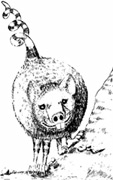
Sidehill gougers are herbivores highly adapted to living on steep hillsides. The legs on one side of their body are longer than the legs on the other, allowing them to stand comfortably on sloped terrain. These creatures come in two varieties: left-handed and right-handed (also known as counter-clockwise and clockwise gougers). The legs of a left-handed gouger are shorter on the left. As a result, it can only travel around a hill counter-clockwise. Right-handed gougers are just the opposite, with legs shorter on the right. They always move clockwise. This business of always moving in the same direction is the source of the gouger's name, because they gouge a path in the side of a hill as they endlessly circle it. If gougers do try to reverse direction, they inevitably topple over.
Right-handed and left-handed gougers, it should be noted, are simply different forms of the same species and can breed together. However, their offspring often end up with mismatched legs (a long leg on their front left and a second long leg on their back right, for instance) making it almost impossible for them to move. Such hybrids usually don't survive long.
Beyond the unusual length of the gouger's legs, little is known about the appearance of this creature. Some say it's badger-like. Some say it's goat-like. One observer, a Harry S. Knight of Camp Wood, Arizona, has been quoted as saying: "A Sidehill Gouger is jest a burrowin' buffalo, sized down and growed crooked."
There have been reports of a Gouger sub-species found in the Appalachians that has fur only on the downward-sloping side of its body. The fur on its other side has been worn away by constant rubbing against the side of the hill. The skin of these creatures, being so highly polished and smooth, is sought after by handbag makers.
References to sidehill-type creatures can be found in records dating back hundreds of years. Sir Thomas Browne, writing in the 17th century, recorded a popular belief that British badgers (popularly referred to back then as "brocks") had legs of different lengths:
"That a Brock or Badger hath the legs on one side shorter then of the other [which] though an opinion perhaps not very ancient, is yet very general; received not only by Theorists and unexperienced believers, but assented unto by most who have the opportunity to behold and hunt them daily." (
Pseudodoxia Epidemica, 1646, Book III, Chapter 5, 'Of the Badger').
In colonial America sidehill-type creatures were referred to as "procks". Evidently a derivative of "brocks". Since then a wide variety of names have been given to these creatures, including: sidehill badger, sidehill winder, sidehill dodger, sidehill wowser, godaphro, and gyascutus. However, sidehill gouger is, by far, the most common name. Other sidehill creatures include the
Rackabore, and the French Dahut. There have also been reports from Scotland of a Sidehill
Haggis.

 Sidehill gougers are herbivores highly adapted to living on steep hillsides. The legs on one side of their body are longer than the legs on the other, allowing them to stand comfortably on sloped terrain. These creatures come in two varieties: left-handed and right-handed (also known as counter-clockwise and clockwise gougers). The legs of a left-handed gouger are shorter on the left. As a result, it can only travel around a hill counter-clockwise. Right-handed gougers are just the opposite, with legs shorter on the right. They always move clockwise. This business of always moving in the same direction is the source of the gouger's name, because they gouge a path in the side of a hill as they endlessly circle it. If gougers do try to reverse direction, they inevitably topple over.
Sidehill gougers are herbivores highly adapted to living on steep hillsides. The legs on one side of their body are longer than the legs on the other, allowing them to stand comfortably on sloped terrain. These creatures come in two varieties: left-handed and right-handed (also known as counter-clockwise and clockwise gougers). The legs of a left-handed gouger are shorter on the left. As a result, it can only travel around a hill counter-clockwise. Right-handed gougers are just the opposite, with legs shorter on the right. They always move clockwise. This business of always moving in the same direction is the source of the gouger's name, because they gouge a path in the side of a hill as they endlessly circle it. If gougers do try to reverse direction, they inevitably topple over.
Comments
walks round a hill, don't turn round!
too late it fell off
Day in, day out, all he knows
More greens 'round the bend
His other favourite story was of the Flying Spokeshave. I'm looking that up next. =)
Nothing is more tragic than the look of a mother Sidehill Gouger whose child is of the opposite orientation. They can only meet twice per circuit around the mountain.
I'm glad to see many people have enjoyed this comical creature over the centuries and look forward to hearing an evolutionist explain its existence someday. They have come up with so many imaginative stories such as life from dead matter that I'm sure they can invent one for this creature!
These were small, non-flying, quail-size birds that lived in nests on the ground.
Over the centuries they so adapted to the steep hillside that they had developed one leg shorter than the other so that they could stand upright on the mountainside.
Their eggs were pyramid-shaped, giving them low center of gravity and preventing their rolling out of the nests.
The version I heard says that the mother hens got turned around in a severe thunderstorm and laid all their eggs facing the wrong direction. When the chicks hatched they had their short legs on the downhill side and rolled out of the nests to their deaths.
So, Side Hill Climbers are extinct and that is why they are not seen around East Tennessee any more.